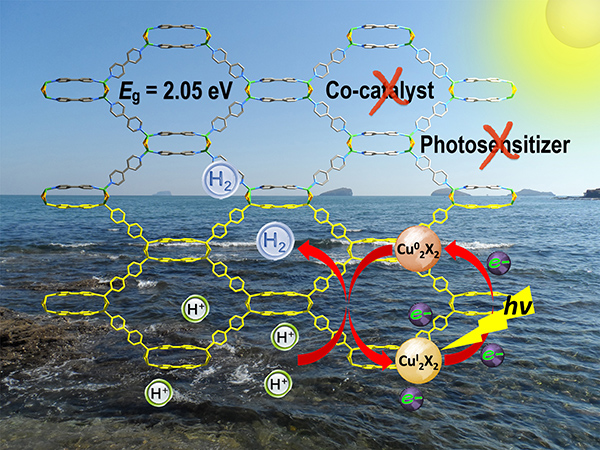| [栏目图片] |
Angew. Chem. Int. Ed.Adopts Research Paper by ZZULI’s Teachers |
|||
|
|
|||
|
|||
|
Recently, a scientific research paper, Semiconductive Copper(I)–Organic Frameworks for Efficient Light-Driven Hydrogen Generation Without Additional Photosensitizers and Cocatalysts, was published in Angew. Chem. Int. Ed. (https://doi.org/10.1002/anie.201709869). Mr. Liu Chunsen and Mr. Du Miao, two professors from the School of Material and Chemical Engineering of ZZULI, are the communication authors. This is the first time for ZZULI to put the research achievement in Angew. Chem. Int. Ed., one of the top journals in the field of chemistry, which is jointly published by John Wiley & Sons, Inc. and German chemical society. (influence factor 11.994). As a kind of energy carrier and considered as one of the most ideal clean energy sources, Hydrogen is environment-friendly because it emits water only when combusted. Photocatalytic pyrolysis of water for hydrogen production is a hot topic in the field of materials, chemistry, energy and environment and it is a challenging task to design and manufacture photocatalytic system with high activity, high stability, low cost and simple technology. By using the cheap Cu (I) ion and bipyridine ligands, the research team succeeded to synthesize the first photocatalytic MOFs materialthat is cocatalyst-independent and self-sensitized, and has the advantages of easy preparation, high activity, high stability. Both theoretical calculation and experiments show that the material possesses similar properties with semiconductor. The Cu2I2 cluster can act as a photoactive center to promote the interaction of copper (I) hydride, and determine the proton reduction sites for hydrogen production. Unlike the previously reported materials that need to be combined with Co catalyst or photosensitizer to achieve high efficiency of hydrogen production by photolysis, this achievement, with simple and low cost, contributes a new idea to produce luminescent catalytic cracking water and the further industrialization of hydrogen production. The team has long worked on the study of molecular based amorphous porous materials, and has published more than 100 papers in well-known journals like J. Am. Chem. Soc. (Impact Factor 13.858) and Coord. Chem. Rev. (Impact Factor 13.324). The team possesses 16 national invention patents.Shi Dongying, the first author of this paper and an outstanding Doctor introduced from Dalian University of Technology in 2016, is mainly engaged in the construction of polyacid @ MOFs composite materials and its applications in photocatalysis, clean energy and hydrocarbon activation. He owns 1 invention patent and has published 13 articles in internationally renowned journals like Sci., Chem. Commun. This research has been funded by the National Natural Science Foundation of China, Outstanding Talents of Science and Technology Innovation in Henan Province, the Central Plains Scholars, Innovative Teams of Universities in Henan Province and the Initial Scientific Research Fund for Doctorates of ZZULI. |
|
Copyright © 2014 Zhengzhou University of Light Industry, China. All Rights Reserved. Add: No.136 Ke Xue Avenue,Zhengzhou,HenanProvince,PRC. Zip Code:450000 It is recommended that you use IE7 and above version of the browser to visit the web site. |
